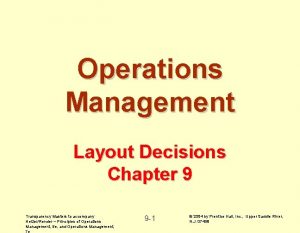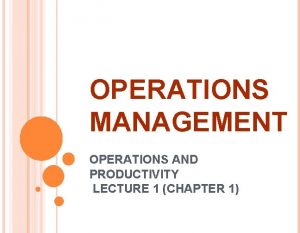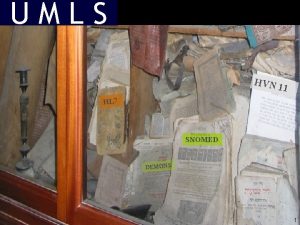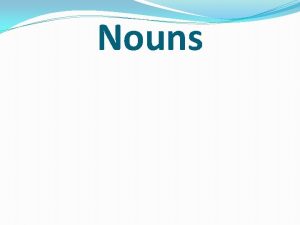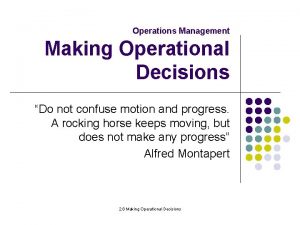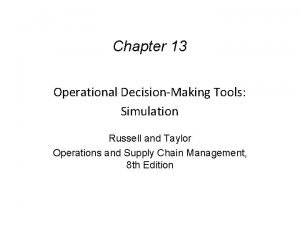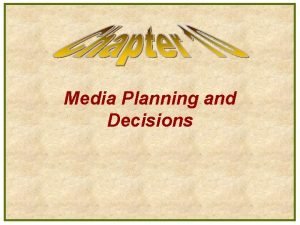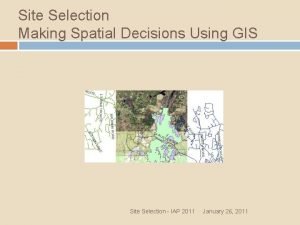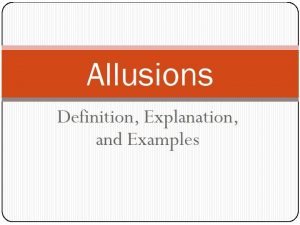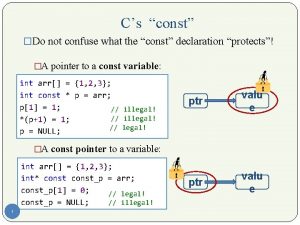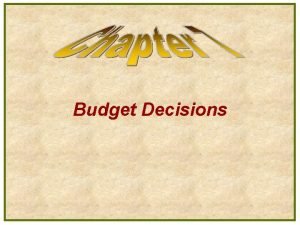Operations Management Making Operational Decisions Do not confuse
















- Slides: 16

Operations Management Making Operational Decisions “Do not confuse motion and progress. A rocking horse keeps moving, but does not make any progress” Alfred Montapert 2. 8 Making Operational Decisions

Making Operational Decisions In this topic you will learn about: l Operational Targets l Calculating and managing capacity utilisation l Operational issues dealing with non-standard orders and matching production and demand 2. 8 Making Operational Decisions

Operational Targets l l l Operations management is concerned with those aspects of the business which are directly linked to the fulfilment of customer orders. Operations management takes inputs, processes them to form an output and distributes to the customer. Operational targets relate to how efficiently aspects of this process are achieved. Inputs Process Working with suppliers Quality Using Technology 2. 8 Making Operational Decisions Outputs Quality Customer Service

Operational Targets l Operational targets relate to a number of measures of efficiency including l Unit Cost l l Quality l l The cost of each individual product or service supplied Quality of raw materials, processes, output and customer service Capacity Utilisation l The extent to which resources are being used (utilised) to their full potential 2. 8 Making Operational Decisions

Operational Targets – Unit Cost l l The average cost of producing a single unit of output Calculated by: l Total Cost / Output Targets will be linked to keeping unit cost as low as possible whilst not affecting quality E. g. a 5% fall in unit cost in 2009 As more units are produced the unit or average cost will fall Fixed Cost = £ 10000 Variable Cost = £ 3 Total Cost for 1000 units = £ 10000 + (£ 3 x 1000) = £ 13000 Unit cost = £ 13000 / 1000 = £ 13. 00 What would be the unit cost if only 500 units were produced? What would be the unit cost if 1500 units were produced? 2. 8 Making Operational Decisions

Operational Targets – Unit Cost l Factors influencing unit costs include l l Number of units produced l Spreads fixed costs l Negotiate discounts with suppliers l Greater use of assets Labour Productivity l Efficiency of work force l Use of workforce hours Suppliers l Cost of inputs Material usage l Wastage 2. 8 Making Operational Decisions What is the link between unit cost and profitability? Should businesses be free to take whatever action they see fit to reduce unit cost?

Operational Targets - Quality l l Quality is about meeting a customer’s expectations Quality targets are likely to impact on all aspects of operations management The Office for National Statistics l Supply of raw materials defines quality as simply “fitness for purpose” l Personnel performance l Customer service and satisfaction l Delivery times l Finished good or service What are the top 5 features you would look for in a pair of jeans? As a class have you listed the same features in the same order? How do these features contribute towards the quality of the product? How might the interpretation of quality change if you were to ask the parent of a young child? 2. 8 Making Operational Decisions

Operational Targets – Capacity Utilisation l Capacity utilisation is a measure of the percentage of potential output being achieved l l Percentage of seats occupied at a football match Percentage of rooms occupied in a hotel Percentage of t-shirts manufactured Calculated by: l Actual output / maximum output x 100 Capacity utilisation in the tourism industry in Scotland The Eden Hotel has 320 rooms of which 250 are occupied Capacity Utilisation = 250 / 320 x 100 Capacity Utilisation = 78% Why might the Eden Hotel use the services of a business such as lastminute. com to try and fill the vacant rooms? 2. 8 Making Operational Decisions

Calculating and Managing Capacity Utilisation l l l The Emirates stadium has a capacity of 60, 335 An Emirates record was achieved in Nov. 2007 when 60, 161 fans watched Arsenal’s 2 -2 draw with Manchester United What was the capacity utilisation for that match? What factors would have influenced the capacity utilisation? What are the advantages of high capacity utilisation? The overall attendance at Emirates Stadium for competitive first-team fixtures during the 2007/08 season was 1, 672, 505. That is an increase of 56, 914 on the previous campaign. How might Arsenal have achieved this increase in capacity utilisation? Is football recession resilient? 2. 8 Making Operational Decisions You will need access to the internet to watch this video clip

Calculating and Managing Capacity Utilisation l Advantages of high capacity utilisation l l l Lower unit costs Job security Improved profitability Image and reputation Funding for expansion l Disadvantages of high capacity utilisation l l l Lack of flexibility Pressure on assets Pressure on staff Loss of development time Maintaining quality Spare capacity is the difference between maximum output and actual output. At Eden hotel there are 320 rooms of which 250 are occupied. The spare capacity is 70 rooms You will need access to the internet to watch this video clip 2. 8 Making Operational Decisions How far will firms go to utilise spare capacity?

Operational Issues – dealing with non standard orders l l l Non standard orders are requests to a company to supply a product or service which does not match their normal provision These are often one off orders or requests Managers will have to decide whether or not to accept the order. Key considerations will include l l l l Capacity Cost Implications Ability to fulfil the order Impact on established customers Potential profitability of the order Brand reputation Impact on normal operations 2. 8 Making Operational Decisions One valuable tool in helping make special order decisions is break even analysis. How might an understanding of break even and contribution help?

Operational Issues – matching production and demand l l l Achieving a balance between supply and demand can be tricky Periods of spare capacity or excess demand have negative effects on operational efficiency In particular difficulties can arise when l Demand fluctuates l l l Seasonality Unpredictable demand Actions of competitors Reactions to marketing Production fluctuates l l l Availability of raw materials Unforeseen stoppages Reliance on nature § § § Crops Water Weather 2. 8 Making Operational Decisions

Operational Issues – matching production and demand l Changing capacity l Overtime l l Asking staff to work longer hours Requires staff commitment Increases wage bill Temporary and part time staff l l l Flexible workforce Recruitment and training issues May be more transient 2. 8 Making Operational Decisions Give an example of how each of these organisations might alter their operations to meet demand • a seaside café in summer • a supermarket at Christmas • a football ground for a cup final • a local hairdressers for a fashion show • a clothing factory with a one off order for T-Shirts for a music festival

Operational Issues – matching production and demand l Rationalisation l Reducing capacity to match smaller demand § § § Selling off assets Laying off staff Moving premises Short term cash outflow l Difficult to reverse Sub-contracting l Asking other businesses to supply goods or services l Flexibility in supply l Quality must be maintained l Sub-contractor will also want to be making a profit l l 2. 8 Making Operational Decisions

Operational Issues – matching production and demand l Managing stocks efficiently l Stock can be used to fill differences between production output and demand Advantages of holding stock Disadvantages of holding stock Ability to meet demand Cost of storage Consistent production quantities Risk of wastage Customer satisfaction Not an option in service industries Ease of operations planning Opportunity cost of resources and money tied up in stock 2. 8 Making Operational Decisions

Activity Oasis Gym is a small independent gym in the centre of Nottingham. The gym offers modern, well equipped facilities including • Swimming Pool, Sauna and steam rooms • 2 studios for aerobic classes • Cardiovascular equipment and free weights area • Beauty salon Due to increased competition from larger gyms Oasis fears that it may have to take drastic action to cut costs unless they can get more customers through the doors. How can Oasis Gym measure capacity utilisation? Why is capacity utilisation likely to vary at different times of day and on different days? As a management consultant you have been invited to a meeting with the manager to look at future options for Oasis Gym. What questions would you ask the manager? Justify your choice. What actions could Oasis Gym take to reduce unit costs without compromising on quality? Oasis gyms has been approached by three local organisations who would like to be able to use the gym at a reduced rate. • A sixth form college for use by students on a Wednesday afternoon as part of their enhancement programme • The Territorial Army for use by cadets on a Saturday morning • A charity working with young adults with disabilities wanting just to use the pool one morning per week What factors would help determine whether or not to negotiate terms with these groups? What advice would you give the manager? Justify your answer 2. 8 Making Operational Decisions
 Good decision making poster
Good decision making poster Barry liked playing board games
Barry liked playing board games Layout decisions operations management
Layout decisions operations management Operations management productivity problems
Operations management productivity problems How does hale confuse tituba
How does hale confuse tituba Confuse
Confuse Confuse
Confuse Essential questions for nouns
Essential questions for nouns What news does bottom bring his companions?
What news does bottom bring his companions? Operational decisions: bump up your bumper
Operational decisions: bump up your bumper Screening decisions and preference decisions
Screening decisions and preference decisions Operational decision making tools
Operational decision making tools Cost per rating point
Cost per rating point An organized method for making good buying decisions
An organized method for making good buying decisions An organized method for making good buying decisions.
An organized method for making good buying decisions. Making spatial decisions using gis
Making spatial decisions using gis Making healthy decisions unit test
Making healthy decisions unit test


